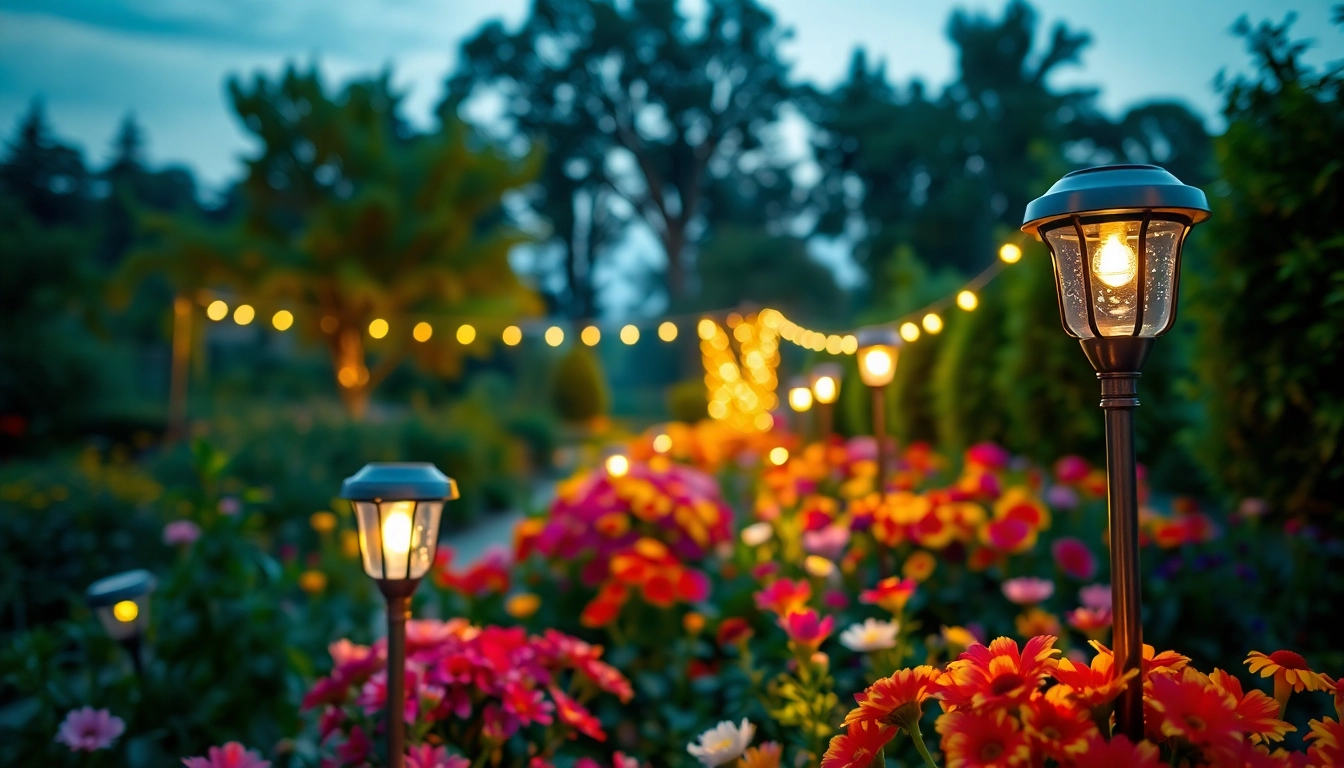
Understanding Solar Lights
As technology continues to evolve, so do our options for outdoor lighting. Among the most popular and environmentally friendly choices available today are solar lights. These innovative solutions harness the sun’s energy to illuminate our gardens, pathways, and patios, combining practicality with sustainability. This guide aims to explore the ins and outs of solar lights, providing you with in-depth knowledge to enhance your outdoor spaces.
What are Solar Lights?
Solar lights are outdoor lighting fixtures powered by solar energy. They typically consist of a solar panel, an LED light source, a rechargeable battery, and a mounting structure. The solar panel collects sunlight during the day, converting it into electricity which is stored in the battery. When dusk falls, the lights switch on automatically, using the stored energy to provide illumination.
How Solar Lights Work
The functionality of solar lights can be broken down into a few key components:
- Solar Panel: This converts sunlight into electrical energy. Modern solar panels are highly efficient, meaning they can generate substantial electricity even with minimal daytime sunlight.
- Rechargeable Battery: The energy produced by the solar panel is stored in this battery, which keeps the lights illuminated during the night or in dim conditions.
- LED Bulbs: Most solar lights use LED technology due to its energy efficiency and longevity. LEDs consume less power and last significantly longer compared to traditional incandescent bulbs.
- Photocells: These sensors detect light levels, allowing the solar lights to turn on automatically at dusk and off at dawn.
Benefits of Using Solar Lights for Outdoor Spaces
Incorporating solar lights into your outdoor spaces offers numerous advantages:
- Energy Efficiency: By relying on renewable solar energy, you significantly reduce electrical consumption, leading to lower utility bills.
- Environmentally Friendly: Solar lights contribute to a reduction in greenhouse gas emissions since they don’t rely on fossil fuels to operate.
- Easy Installation: Most solar lights are designed for simple installation with no need for electrical wiring, making them perfect for DIY projects.
- Low Maintenance: Solar lights require minimal upkeep, primarily just occasional cleaning of solar panels to ensure optimal energy absorption.
- Versatility and Aesthetic Appeal: With various designs available—from pathway lights to decorative lanterns—solar lighting can enhance the beauty of your outdoor areas while serving functional purposes.
Types of Solar Lights for Gardens
With an array of options available, selecting the right type of solar lights can significantly impact the look and usability of your outdoor spaces. Here are some of the most popular types suited for gardens:
Pathway and Downlight Solar Lights
Pathway lights are a practical choice for illuminating walkways, driveways, and garden pathways. These lights not only enhance safety by guiding footsteps at night but also add an inviting appeal to your landscape. Common features include:
- Height: Typically ranging from 12 to 30 inches tall, they are designed to cast light downwards along a path.
- Integrated Stakes: Most pathway solar lights come with pre-installed stakes for easy installation in soil or soft surfaces.
- Design Variety: Available in various styles—modern, traditional, fairy-tale—these lights can complement your garden’s theme.
String Solar Lights for Festive Ambiance
String lights are perfect for creating a cozy, whimsical atmosphere during gatherings and celebrations. They can be draped across garden trellises, fences, or trees, providing a soft glow ideal for evening events. Considerations when choosing string solar lights include:
- Length and Quantity: Measure your space to determine how many strands you might need.
- Light Color: Warm white lights generally offer a more intimate feel, while vibrant colors may suit festive occasions.
- Durability Features: Ensure the lights have weatherproof ratings for outdoor longevity.
Decorative Solar Lanterns and Sculptures
Beyond functional lighting, decorative solar lanterns and solar-powered sculptures can serve as beautiful garden features during the day and illuminate nighttime landscapes. These are great conversation starters and can add character to your garden. When selecting decorative solar lights, consider:
- Design and Theme: Choose lanterns and sculptures that harmonize with your garden’s overall aesthetic.
- Backup Features: Some solar lanterns come with the option for internal lighting systems for cloudy days.
Choosing the Right Solar Lights
Selecting the perfect solar lights can be overwhelming given the range available in the market today. Here are some factors to help you narrow down your choices:
Factors to Consider: Brightness, Style, and Placement
Different areas of your garden may require varying degrees of brightness. Some key points to keep in mind include:
- Measuring Lumens: More lumens mean brighter lights; consider what lighting effect you are aiming to achieve.
- Style Compatibility: Your chosen solar lights should match the visual theme of your garden or home.
- Strategic Placement: Position lights where they will provide optimal illumination for its intended area—such as near pathways, seating areas, or winding trails.
Weatherproof Options for Durability
Since solar lights are exposed to outdoor elements, investing in weather-resistant models is crucial. Here are some pointers:
- IP Rating: Pay attention to the Ingress Protection (IP) rating of the solar lights, which indicates their resistance to dust and water. Look for lights rated IP65 or above for solid protection.
- Durable Materials: Opt for materials like stainless steel or high-quality plastic that can withstand rust and corrosion.
Energy Efficiency and Cost-Effectiveness
Investing in solar lights means not just focusing on upfront costs, but considering the long-term savings:
- Calculate Energy Savings: Since solar lights run on sunlight, you can expect significant reductions in energy bills compared to traditional electric lights.
- Longevity: High-quality solar lights can last for years, ensuring that your investment pays off over time in both performance and savings.
Installation and Maintenance of Solar Lights
Installing and maintaining solar lights is typically straightforward, setting them apart from traditional outdoor lighting options. Here’s how to ensure they perform at their best:
Step-by-Step Installation Guide
Follow these general guidelines for installing solar lights:
- Choose Your Location: Identify areas that receive ample sunlight throughout the day.
- Prepare the Ground: Clear away any debris and ensure the ground is soft enough for inserting stakes.
- Position the Light: Insert the solar light stake into the ground, ensuring the solar panel faces the sun and the lights are at a height that maximizes their efficacy.
- Check the Switch: Make sure the light’s switch is on and allow it to charge for at least a full day before testing.
Cleaning and Maintenance Tips for Longevity
Proper maintenance can significantly lengthen the life of your solar lights. Here are some tips:
- Regularly Clean the Solar Panels: Dust and debris can accumulate on the panels, reducing their efficiency. Clean gently with a damp cloth monthly.
- Inspect for Damage: Periodically check for any signs of wear, such as cracks in the body or loose connections. Replace parts as needed.
- Battery Maintenance: If you notice poor performance, the battery may need to be replaced. Most batteries last around 2 to 4 years.
Understanding the Impact of Seasonal Changes
Seasons can influence the performance and longevity of solar lights significantly.
- Winter Considerations: In winter months, ensure the solar panels aren’t covered by snow or ice, as this obstructs sunlight absorption.
- Daylight Savings Adaptation: Remember to adjust the settings if they have an override switch for daylight savings time changes.
- Moisture and Humidity Awareness: In regions where rain is predominant, ensure proper drainage around the fixtures to prevent water buildup inside the units.
Enhancing Your Outdoor Experience with Solar Lights
When applied creatively, solar lights can transform outdoor spaces, ensuring they are attractive and functional. Here are some ideas to enhance your experience:
Creative Ways to Use Solar Lights in Your Garden
Consider these innovative ways to integrate solar lights:
- Highlight Garden Features: Use solar spotlights to illuminate your favorite garden features like sculptures or plants.
- Define Spaces: Use solar pathway lights to mark paths around your garden and delineate flower beds from grassy areas.
- Temporary Installations for Events: For parties or gatherings, string lights or lanterns can add charm and create ambience.
Best Practices for Lighting Design
Lighting design plays a crucial role in enhancing aesthetics and functionality. Here are best practices:
- Layer Lighting: Utilize a combination of ambient, task, and accent lighting to create depth and interest in your space.
- Use Different Heights: Varying the installation heights of your solar lights adds variety and visual appeal.
- Test Different Configurations: Before finalizing the placement, experiment with different layouts to find what works best for your landscape.
Real-Life Examples and Inspirations
Many homeowners successfully use solar lights creatively. Here are inspirational ideas:
- Garden Wedding Venues: Many outdoor venues use solar string lights draped over trees and garden spaces to create magical settings.
- Pathway Markers: Homeowners frequently illuminate their driveways and pathways with solar lights, enhancing both security and aesthetics.
- Artistic Displays: Some creatively incorporate solar lanterns into water features or as part of sculptures, turning their gardens into art installations.





